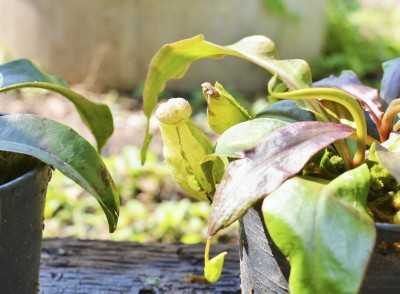






Pitcher plant is a fascinating carnivorous plant that has ornamental appeal while entertaining and educating on a unique method of feeding. Propagating pitcher plants can be done by tissue culture, seed or stem cuttings. Rooting cuttings is the more common method for a home gardener. Pitcher plant cuttings must be taken at the right time of the year and from a mature plant. Collectors know how to propagate a pitcher plant so we’ll take some tips from them and explore the world of pitcher plant growing.
The pitcher plant has a silhouette that most gardeners can recognize. The plants produce male and female flowers on separate plants. The two sexes appear identical and make it nearly impossible to ensure that you have one of each. Additionally, the plants need to be flowering at the same time in order for the male’s pollen to transfer to the female bloom. This is as likely as my winning the lottery in any environment but nature. Rooting cuttings is a far easier and surer way to propagate pitcher plants. There are two methods that should do the trick and produce new pitcher plants in a month or two.
Plants in nature produce offspring through seed. Baby plants take a long time to develop and fertilization is capricious in nature. A gardener who wants to undertake propagation through seed will need patience and a lot of luck. Tissue cultured plants are best left to those professionals in the nursery industry or someone with a botany degree.
Cuttings, however, grow quickly and are easy for even a novice gardener to undertake. Cuttings from mature plants with actively growing stems work best. When the plant begins to produce vining stems, harvest a climbing stalk that has a basal rosette. Use a clean, sharp razor and take the stem just below a lower leaf with a growth bud. Count 3 nodes and make your cut.
Once you have your cutting, it is time to root the material. Pitcher plant cuttings can be rooted in water or in a soilless medium. Use rain or distilled water and immerse the end of the cutting and the first growth node in the liquid. Place the glass in a bright area where temperatures are moderately warm. Change the water at least once per week.
The stem should split in less than two weeks and begin to produce tiny rootlets. If the cutting is a piece of the tip of the stem, the end growth should continue growing. When the cutting has 6 rootlets, plant it in sphagnum moss. Keep the cutting moderately moist.
In six months or more, the plant will develop a classic pitcher form. Propagating pitcher plants in this way is quite easy, but you have to watch the cutting for any signs of fungus or rot.
Harvesting a cutting that will grow in moss is the same as that for a water grown plant. Professionals use rooting hormone on the end of the cutting and often a fungicide. If you have a sterile medium, the fungicide is not necessary but the rooting hormone helps enhance the plant’s ability to send out rootlets.
Sphagnum moss or a 50/50 mixture of coir and perlite create ideal conditions when growing pitcher plants from cuttings. Remove the bottom leaf and settle the stem into the medium with the remaining two leaves above the surface. Make sure the cutting has one growth bud below the surface of the medium. Lightly moisten the medium and place the container in a plastic bag.
Keep the container in a brightly lit area. It can take six months to a year to see new growth while rooting takes place. Do not disturb or repot the plant until new growth is observed. It’s a tedious wait, but the benefits will be clear when your new pitcher plant begins to produce its characteristic hood.
Copyright © www.100flowers.win Botanic Garden All Rights Reserved